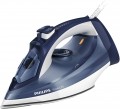Iron soleplate cover. This surface is in direct contact with the fabric, and therefore the type of coating is one of the most important characteristics.
—
Aluminium. Aluminium, being a simple and cost-effective choice, offers advantages such as low weight and rapid heating. However, it is prone to quick scratching, diminishing ironing quality and potentially damaging processed fabrics. Overheating may cause aluminium to stick to fabric, posing cleaning challenges. As a result, "pure" aluminium is often found in the most budget-friendly or compact irons. Some manufacturers employ special technologies in aluminium soleplates to mitigate these drawbacks to some extent.
—
Stainless steel. Inexpensive and at the same time very practical material, the most common version of the metal soleplate in modern irons. True to its name, "stainless steel" is highly resistant to corrosion, yet it is durable, free of scratches and burrs, glides well and is easy to clean. Of the significant shortcomings of this material, one can only note a rather large weight.
—
Ceramic. The main advantage of ceramics is that it glides much better than steel or aluminium. In addition, this material is easy to clean and practically does not scratch. On the other hand, ceramic soleplates are quite fragile and can break or chip from a strong impact.
—
Metal-ceramic. Material generally similar to the ceramics described above; may be somewhat stronger due to the addition of metals, but in fact it all depends on the specific composition.
— Tourmaline. Another type of ceramic material containing tourmaline is a natural semi-precious stone. A feature of tourmaline soleplates is a natural antistatic effect, which is especially useful when ironing light fabrics: such fabrics will not stick to the soleplate due to static charge.
—
Titanium/ceramics. Metal-ceramic (see above), which includes titanium. This metal is characterized by high strength and wear resistance, which has a positive effect on the overall reliability of the soleplate.
—
Teflon. Teflon (polytetrafluoroethylene) enables smooth gliding of the iron over fabric and offers non-stick properties. This coating is easily cleaned, resists sticking to clothes, and remains relatively clean even in situations like overheating and burning through materials. However, a notable drawback of Teflon is its high sensitivity to scratches, necessitating caution when ironing items with metal buttons, fasteners, or decorative elements.
—
Non- stick. This category includes all types of non-teflon non-stick coatings (see above). The specific composition and properties of such a coating may be different. For example, in some models it is the same PTFE, just not called Teflon (the word "Teflon" is a registered trademark and may not be used without permission). In addition, there are other materials. A common feature of all such coatings is that almost no dirt sticks to them, which greatly simplifies the cleaning of the soleplate.
—
Titanium. One of the most advanced options. Titanium is extremely durable and virtually unaffected by chips and scratches, even from falls and other serious "accidents". On the other hand, it does not heat up very quickly, but is very expensive. Therefore, such a coating is rare, mainly in premium irons.
—
Enamelled. Typically, these soleplates feature a stainless steel base with a specialized enamel coating. The enamel composition is chosen for both smooth gliding and durability. The primary advantage lies in the reliability of this coating, which is highly resistant to scratches—many enameled soleplates can withstand cleaning with metal brushes. However, it's worth noting that irons with such coatings come with a corresponding higher cost.
The steam supply power provided by an iron is essentially the amount of steam supplied by the device per minute. In most modern irons, the intensity of steaming can be adjusted, so this item usually indicates the maximum power value.
The more steam the iron supplies, the more intense the effect on the fabric, the more dense and rigid materials can be effectively smoothed out without resorting to a steam boost (see below). On the other hand, high performance significantly affects the price, dimensions and weight of the iron. Accordingly, it is worth choosing according to this indicator taking into account the planned method of application — especially since the full power of steam is far from always required, and in special cases the same steam boost can be used.
In travel and simple household irons, the productivity is about 15 – 30 g/min. More than 30 g/min corresponds to enhanced steaming, and the most advanced devices, mainly for professional use, are capable of producing 60 g/min or more (the so-called “turbo mode”).
The steam power supplied by the iron in boost mode.
The steam power is the amount of steam the iron produces per minute. See above for more information on the general meaning of this parameter. And the steam boost mode is a mode of enhanced steaming, when the iron practically “shoots” with a boost of steam; "shot" is usually made by pressing a special button. Steam boost allows you to achieve an intense effect that is not available with conventional steaming; such an impact can be useful, for example, to smooth out heavily rumpled fabrics that would be difficult to deal with in other ways.
A steam boost of 100 g/min or more is said to be sufficient to handle most tough and "unruly" materials. And
models with a powerful steam boost from 200 g/min will definitely not leave even the most dense fabric rumpled. However, there are models with more modest indicators — they are quite suitable for those who need an iron for ordinary household ironing. Moreover, high power, usually, affects the cost. Do not forget about irons with a steam generator, where the performance values are higher, since the purpose of the iron is slightly different.

